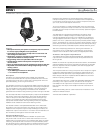
broadcast & production microphones
BPHS1
Broadcast Stereo Headset
Features
• Microphone features polar pattern and frequency response tailored
for natural, highly intelligible vocal reproduction
• Closed-back circumaural ear cups help seal out crowd noise and
other background distractions
• Neodymium magnets in microphone and headphones for high
output level & detailed sound reproduction
• Rugged design with user-replaceable cable and ear pads
• Cardioid pickup pattern of the dynamic microphone rejects
off-axis sounds
• Boom-mounted microphone can be positioned on the left or right side
• Adjustable cushioned headband and lightweight design for long-
wearing comfort
• Cable terminations:
- 3-pin XLRM-type connector for microphone
- ¼" 3-conductor for headphones
Description
The BPHS1 is a rugged broadcast stereo headset with closed-back
circumaural (around-the-ear) ear cups and a professional boom-mounted
microphone that can be worn on either side. It is designed for news and
sports broadcasting, announcing and interviews.
The headset’s microphone has a cardioid polar pattern tailored for pickup of
speech with maximum voice intelligibility over a wide range of frequencies.
It is more sensitive to sound originating directly in front of the element,
making it useful in reducing pickup of unwanted sounds. The exible
gooseneck boom swivels for easy positioning on either the right or left side.
The dual earphones offer an extended frequency response of 20-20,000 Hz
and smooth, natural sound reproduction. At the heart of each earpiece,
a 40 mm neodymium driver offers impressive power handling for high
maximum sound pressure levels. Generously padded circumaural ear
cups provide acoustic isolation and long-wearing comfort; the adjustable
headband is also crafted and cushioned for listening comfort.
The headset includes a user-replaceable detachable 3.3 m (10.8') cable
terminating in two output connectors, one each for the microphone and
headphone: the microphone output is a 3-pin XLRM-type connector; the
headphones’ output is a 3-conductor ¼" connector. Three windscreens are
also included to protect against noise from breath and wind.
Operation & Maintenance
The BPHS1 broadcast headset features a exible microphone boom
that pivots so that it can be worn on either side of the face. Put on the
headset with the microphone boom on the desired side. (Note: For stereo
monitoring, the earphone with a red insert on the yoke assembly carries
the right stereo channel.) Adjust the boom as needed to follow the contour
of your face, positioning the microphone near the corner of your mouth.
Experiment with placement for optimal performance: Positioning the
microphone closer to your mouth will increase the low-end response for
a more robust, full-range sound. As you move the microphone away from
your mouth, the low-end response will diminish.
To remove included 3.3 m (10.8') shielded cable, loosen and remove the
thumb screw and pull the multi-pin connector out of its socket. To replace
the cable, plug the multi-pin connector into the socket, replace and tighten
the thumb screw.
The cable features a standard 3-pin XLRM-type microphone output
connector and a ¼" headphone output connector. Output from the
microphone’s XLRM-type connector is low impedance (Lo-Z) balanced.
The signal appears across Pins 2 and 3; Pin 1 is ground (shield). Output
phase is “Pin 2 hot”– positive acoustic pressure produces positive voltage
at Pin 2. The headphone ¼" connector is wired for stereo operation: the end
portion of the connector (Tip) carries the left channel; the center portion (Ring)
carries the right channel; and the bottom portion (Sleeve) carries the ground.
Take care to keep foreign particles from entering the windscreen. An
accumulation of iron or steel lings on the diaphragm, and/or foreign
material in the windscreen’s mesh surface, can degrade performance.
Architect’s and Engineer’s Specications
The headset shall be a stereo broadcast headset with closed-back ear
cups and a boom-mounted microphone that can be positioned on the
left or right side.
Padded circumaural ear cups shall provide acoustic isolation; the headband
shall be adjustable and cushioned. The earphones shall have an extended
frequency response of 20 Hz to 20,000 Hz, and shall be equipped with
40 mm neodymium drivers.
The microphone shall be a moving coil dynamic with a neodymium magnet.
It shall have a cardioid polar pattern and a frequency response of 40 Hz to
20,000 Hz. Nominal open-circuit output voltage shall be 1.4 mV at 1V, 1
Pascal. Output shall be low impedance balanced (560 ohms). The boom
shall be of a pivoting, exible design.
The headset shall have a 3.3 m (10.8') user-replaceable detachable cable
terminating in two output connectors, one each for the microphone
and headphone. The output of the microphone shall be a 3-pin XLRM-
type connector. The output of the headphone shall be a 3-conductor ¼"
connector.
Weight shall be 264 g (9.3 oz). It shall include three windscreens. Finish
shall be low-reectance black.
The Audio-Technica BPHS1 is specied.




